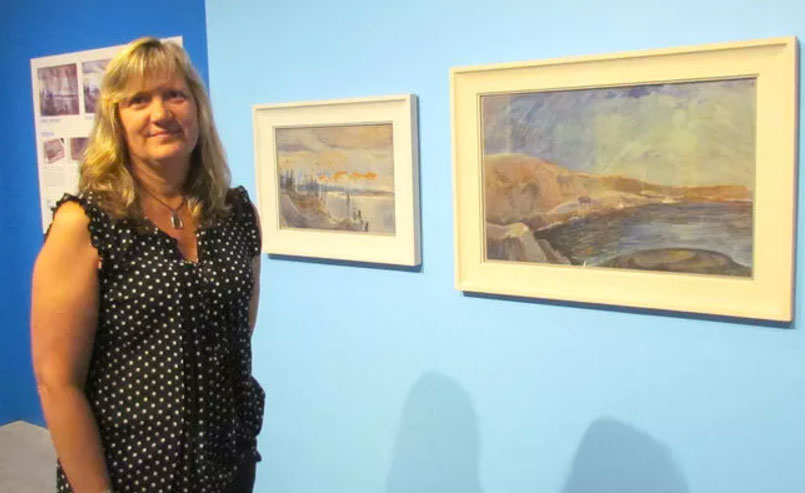Emily Carr paintings exhibited for the first time

Shelly Mallon, art collection officer with the Judith and Norman Alix Art Gallery in Sarnia stands Tuesday July 18, 2017 next to two newly conserved paintings by Emily Carr. The paintings by the iconic Canadian artist were donated to the gallery in 2015 and are being exhibited there for the first time as part of the show Heavy Hitters: The Group of Seven and Contemporaries. Paul Morden/Sarnia Observer]
The Judith and Norman Alix Art Gallery's collection of work by Emily Carr tripled in size in 2015 with the donation of two paintings on paper by the iconic Canadian artist.
The newly acquired oil paintings are being shown for the first time at the public art gallery in downtown Sarnia in the exhibition, Heavy Hitters: The Group of Seven and Contemporaries, following extensive conservation work.
Jennifer Robertson, a London-based conservator who worked on the paintings, is set to talk about the project and her work during a presentation at the art gallery Thursday at 7 p.m.
“It's an amazing gift,” curator-director Lisa Daniels said about the donation of the Carr paintings that came to the gallery from Pamela B. and Ian W. E. Harris of Sarnia.
“We had one Emily Carr for a number of years, and to have more works by an artist like her coming to the collection gives us a chance to show the community a broader depth of her practice.”
The British Columbia-born artist lived from 1871 to 1945 and studied in San Francisco and Paris before returning to Victoria, where she supported herself by running a boarding house while painting and writing.
In the 1920s, she met Lauren Harris and other members of the Group of Seven and was welcomed into their company, eventually earning recognition, but not wealth, for her paintings.
“This was a real treat when these came forward,” Daniels said about two Carr landscapes in the exhibition.
But first, the paintings needed conservation work.
“Emily Carr is known for doing her paintings on butcher paper with gasoline as a medium,” making conservation of her work a “huge issue” in the world of Canadian art, Daniels said.
“A lot of her pieces never come out, because they're just so fragile. She would just paint on whatever she could get her hands on.”
Within the Victorian era of British Columbia “she was quite a unique character,” Daniels said.
Today, Carr is considered the “grand female artist” of Canadian art history, Daniels said.
The gallery's permanent collection began with Canadian works of art purchased by the Sarnia Women's Conservation Art Association in the years following the First World War.
The Sarnia group was an early supporter of the Group of Seven and 25 pieces of art purchased by the association were donated in the early 1950s to the Sarnia Public Library, forming the base of the permanent collection of Canadian art now held by the county-owned public art gallery.
That collection has grown over the years to well more than 1,200 works of art, thanks to donations by collectors in Sarnia and elsewhere.
The exhibition is the final show in the gallery's Share the Passion: Gifts of Art series honouring the collection's donors.
“We rely a lot on donations of art because we could never afford to purchase these,” Daniels said.
The gallery doesn't release the appraised value of the collection, or its individual pieces
Daniels said the condition of art is often a consideration when the gallery is approached by potential donors because “we then become responsible for the care of these works.”
In the case of the two Carr paintings, that work involved stopping their deterioration.
One of the paintings was glued to plywood and the other to cardboard, and the paper was yellowed and brittle.
Robertson said this was her first experience conserving work by Carr, but added she specializes in works on paper and has experience working on similar projects.
“It really is less about the artist and more about the materials,” she said.
“As long as you're familiar with paper and the different processes that are employed to conserve and clean it, they tend to react similarly.”
The Carr paintings are on wood pulp paper that had yellowed over the years, Robertson said.
Information boards with photographs and descriptions of the conservation work hang next to the paintings in the gallery to tell the story of their conservation.
“That freaks me out,” Daniels said about a photo in the display of one of the Carr paintings submerged in distilled water during the conservation work.
“It is actually a pretty common treatment for works of art on paper,” Robertson said.
“As long as you've done property testing and made sure everything is going smoothly and very controlled, it's very beneficial to the paper.”
The information displays in the exhibition allow the gallery to shine light on a side of its work the public may not allows be aware of.
“We don't just store art and bring it out,” Daniels said.
“A lot of the work we do, our responsibility, is behind the scenes caring for the work and making sure it's available 100 years from now.”
The exhibition also includes a series of 12 small paintings A. Y. Jackson painted on a trip to the Canadian Arctic and purchased by the Sarnia Women's Conservation Art Association, as well as other pieces. They include Edwin Holgate's The Lumberjack and Chill November, a painting by Tom Tomson the gallery recently discovered is believed to be the last large piece by the Canadian artist before his death 100 years ago.
The exhibition runs until Aug. 6.
Orignal Article
